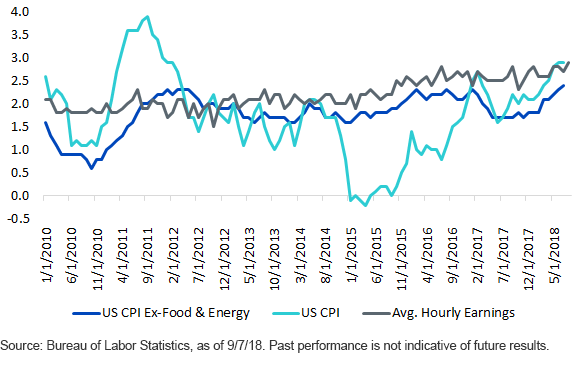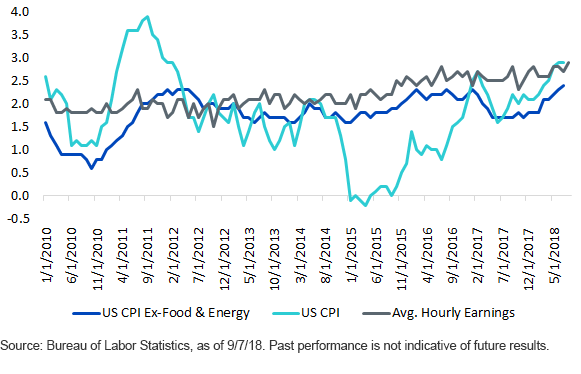The money and bond markets received another solid jobs report last week. Indeed, the unemployment rate remained at historic lows, while new job creation maintained its upward trajectory compared to 2017. The fixed income arena has become somewhat accustomed to this development, and as a result, the attention has shifted to another vital part of the monthly employment data: wages.
As I mentioned in the August 8, 2018, blog post, “Stuck in a Moment and You Can’t Get Out of It,” the wage aspect of the broader economic landscape had been a bit of a disappointment. It’s not that wages were declining; it’s that the pace of growth for average hourly earnings (AHE) was relatively flat and mired in a narrow range. Sure, the bond market had seen its share of surprises to the upside, but these surprises tended to be essentially false starts and either short-lived or, even worse, revised downward in later reports.
Inflation vs. Wages

That brings us to the latest jobs data for August. The Bureau of Labor Statistics reported that the year-over-year rate increase for AHE came in at 2.9%. This reading was not only 0.2 percentage points higher than consensus estimates, but it also represented the highest level since 2009.
Prior to the August print, AHE in 2018 had been stuck in a range of +2.6% to +2.8%, so the natural question becomes whether this latest move to the upside will also be fleeting, or has a new, more elevated trend commenced? Certainly, the underlying data were encouraging because wage gains were not just centered on one or two groupings but were more widespread. Another key point is that the jobless rate remains at 3.9%, a figure that, if sustained, would seemingly be a positive sign for future wage growth as well.
Let’s look at this from a broader inflation picture. Thus far in 2018, inflation has been flying under the radar. In other words, the Consumer Price Index (CPI), on both a headline and core (excluding food and energy) basis, has been making inroads to the upside, but the bond market has apparently not given this development too much thought. To be sure, after a boost in late 2017 and early this year, inflation expectations have remained fairly anchored. So what has been the missing ingredient to the inflation backdrop? Wages. If this latest wage gain is “for real,” anxiety levels in the U.S. Treasury (UST) market may start creeping higher, notwithstanding escalated trade wars or further deterioration in the emerging market landscape.













Leave A Comment